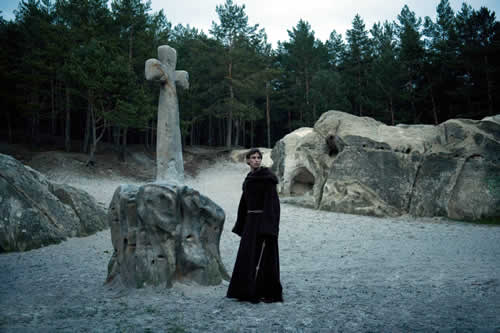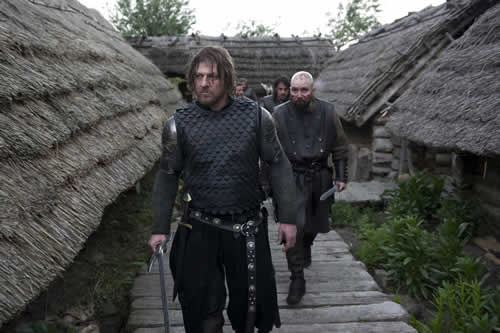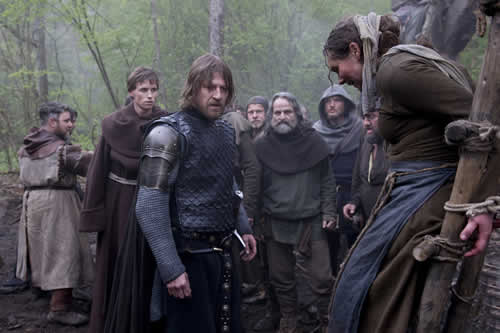 Black Death happens in 1348, When Europe has fallen under the shadow of the Black Death. As the plague decimates all in its path, fear and superstition are rife. In this apocalyptic environment, the church is losing its grip on the people. There are rumors of a village, hidden in marshland that the plague cannot reach. There is even talk of a necromancer who leads the village and is able to bring the dead back to life. Ulric (Sean Bean), a fearsome knight, is charged by the church to investigate these rumors. He enlists the guidance of a novice monk, Osmund (Eddie Redmayne) to lead him and his band of mercenary soldiers to the marshland, but Osmund has other motives for leaving his monastery. Their journey to the village and events that unfold take them into the heart of darkness and to horrors that will put Osmund’s faith in himself and his love for God to the ultimate test.
Black Death happens in 1348, When Europe has fallen under the shadow of the Black Death. As the plague decimates all in its path, fear and superstition are rife. In this apocalyptic environment, the church is losing its grip on the people. There are rumors of a village, hidden in marshland that the plague cannot reach. There is even talk of a necromancer who leads the village and is able to bring the dead back to life. Ulric (Sean Bean), a fearsome knight, is charged by the church to investigate these rumors. He enlists the guidance of a novice monk, Osmund (Eddie Redmayne) to lead him and his band of mercenary soldiers to the marshland, but Osmund has other motives for leaving his monastery. Their journey to the village and events that unfold take them into the heart of darkness and to horrors that will put Osmund’s faith in himself and his love for God to the ultimate test.
Here is CWB’s interview with Christopher Smith, director of the Black Death:
Bijan Tehrani: How did you come up with the idea of making the Black Death?
Christopher Smith: Well it wasn’t originally my idea it came from a writer name Dario Paloni who had written a script for a film that dealt with a clash between the church on one hand and the devil of the other for the soul of a young monk. The second half of the script was different from the version of the film that you see. In script the second half of the movie was more literal and dealt with the head of the village, the devil and at the end of the movie villagers are in hell, this part it was more of a theological debate between good and bad. But I wanted to put that into a more realistic context and I wanted to show what this village would be like in the real world and what would the opposition to Christianity be like in the real world and how these two could clash. So the film came about organically.
BT: What sets your film apart from other movies of its kind, is that yours is not a so called costume drama, it looks quite real.
CS: Thank you, you are right, primarily if you look at any costume drama they always start by showing you the set and showing you the clothes. I thought that my film had a big story and all those things are unimportant. So interestingly two days into shooting I was looking at the people in costumes on the set and I was thinking oh God! I am making a medieval movie. But by the second day I wasn’t even thinking about it and I think that translated to the screen.
 BT: One other interesting aspect of Black Death is that you can relate it to what happens in our world today.
BT: One other interesting aspect of Black Death is that you can relate it to what happens in our world today.
CS: Yes, I used fear of fundamentalism and I started the film with a young moderate Christian character who wants to love god and love a woman at the same time and by the end of the film he is radicalized into someone different. I thought his life spread across a mission or a war with another rival or country how changes him. Of course this does not come across as heavy handed as it looks and I just told the story and I knew that if I told the story straight and used the violence in a very convincing way, then you can see how things have not changed in 600 years.
BT: How did you come up with visual style of Black Death?
CS: I think there is nothing scarier than what you see in the news and realizing that I was making something that has some historical truth into it, even though it has occurred 600 years ago, I figured that I would shoot it as if it happened 10 years ago and I treat it visually like news. I know that when you see this style in the film, images will have an effect on you and engage you deeper into the story.
BT: How did you go about casting the film?
CS: We had Sean attached already, you have seen Sean in films like this, but you have never seen him quite so hard core as in this film. The way his character sees the world is very scary and I thought that Sean would be the best person to do that. Then with Carice Van Houten as the leader of the village, I just loved from watching her in Black Book. I wanted the leader of the village to be seductive and to have an aura and I felt that she had that. Plus she has two sides to her face where she is very pretty but also has this film  noir/femme fatale side. The other major role is played by Eddie Redmayne who plays the monk and hes a great look to him that is fierce, so when you see him as a monk he looks as though he is a monk and not a Hollywood beach boy; I wanted him to look like a very pious person.
noir/femme fatale side. The other major role is played by Eddie Redmayne who plays the monk and hes a great look to him that is fierce, so when you see him as a monk he looks as though he is a monk and not a Hollywood beach boy; I wanted him to look like a very pious person.
BT: How do you work with the actors, do you encourage any improvisation?
CS: We just went for a very naturalistic style, the actors were very natural, if the sword was heavy then they showed that it was heavy, we wanted them to respond as a human being would; if their friend had died you would see how sad they were, if they killed a man on the battlefield you would see the remorse on their faces. This is all the stuff that you see in the war movies, so we were just transplanting the energy that you get form war and tell the actors to act as if these were events that really happened.
BT: Do you have any future project lined up?
CS: I am working on a film noir and also a werewolf film and I want to do it properly, I want to do it with practical effects. The movies I am making are much more film movies, the last two films that I made are very serious but I want to do a film that have a bit more laughs on set.

